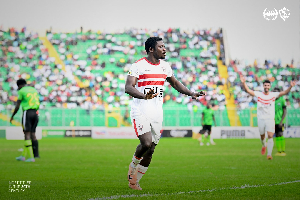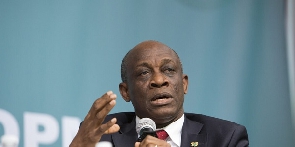- Home - News
- TWI News | TV
- Polls
- Year In Review
- News Archive
- Crime & Punishment
- Politics
- Regional
- Editorial
- Health
- Ghanaians Abroad
- Tabloid
- Africa
- Religion
- Election 2020
- Coronavirus
- News Videos | TV
- Photo Archives
- News Headlines
- Press Release
Business News of Thursday, 16 February 2012
Source: Lawrence Quartey
Ghana's total debt stock up 34 per cent in 2011

Ghana's total debt rose by 34.09 per cent rising to GH¢23.6 billion (over $14 billion), equivalent to 44.2 percent of Gross Domestic Product, the central bank governor announced.
??Domestic debt increased by 43 per cent year-on-year to GH¢11.84 billion in 2011, from GH¢8.3 billion the previous year, while external debt stock also increased by 20.1 per cent compared the corresponding period in 2010.
Presenting a report from the Monetary Policy report, central bank governor, Kwesi Amissah-Arthur, on Wednesday said fiscal operations saw revenue and grants in 2011 amounting to GH¢10.7 billion, compared to GH¢7.5 billion in 2010.
Total expenditure, on the other hand, was GH¢12.7 billion in 2011, compared to GH¢9.2 billion in 2010 with wages, salaries and related expenditures surging from a little over GH¢2 billion to GH¢5.2 billion.??
"Fiscal operations in 2011, therefore, resulted in a narrow budget deficit of GH¢2.1 billion and was financed mainly through the issuance of domestic bonds," the governor said.
Net Domestic Financing of GH¢2.1 billion was within the projected target of GH¢2.4 billion.
On the external front, the country's overall balance of payments recorded a surplus of GH¢941.07 million in 2011, significantly down from the GH¢1.5 billion surplus recorded in 2010. Amissah-Arthur attributed the decline to the widening of the current account deficit.
The current account balance worsened in 2011 as a result of increased net outflows in the Services and Income Account, which rose to US$3.1 billion in 2011 from $2.1 billion in 2010.
Total merchandise exports grew by 60.6 per cent in 2011 to $12.7 billion, supported by oil exports and favourable commodity prices. ??Gold exports amounted to $4.9 billion while cocoa beans totalled $2 billion and the value of crude oil exports was $2.7 billion over the same period.
Total merchandise imports grew by 46.2 percent in 2011 to $15.9 billion.?? Crude oil imports amounted to US$1.4 billion while imports of refined oil products were $1.7 billion and gas imports were estimated at $172.8 million.
Total non-oil imports amounted to $12.7 billion and by end-use, capital imports were $2.7 billion, intermediate imports amounted to $6.1 billion, consumption goods, $3.0 billion and others constituted $900 million.
The governor noted that the rapid growth in imports 2011 and the unusual surge in demand for foreign exchange during the last quarter of the year created a misalignment in the bank's foreign exchange cash flow.
The Capital and Financial Account surplus improved to $4.5 billion in 2011 from a surplus of $4.3 billion in 2010, driven by net inflows of private capital investments mainly into the oil sector.??
Gross international Reserves of the Bank of Ghana improved to US$5.4 billion in 2011 from US$4.7 billion in 2010, but Amissah-Arthur said that declined to GH¢4.6 billion as at January 2012 due to the increased demand for foreign exchange resulting from the higher than normal surge in seasonal demand to support trade.










